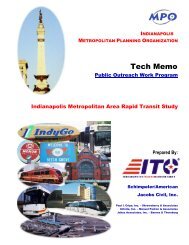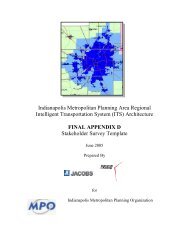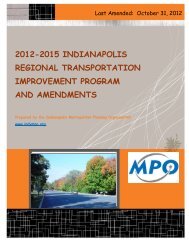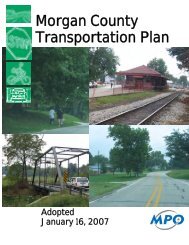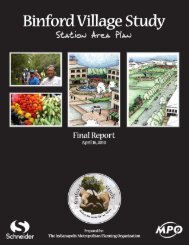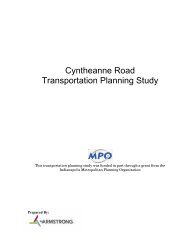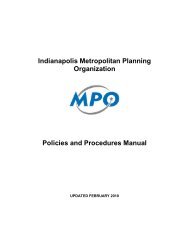IRTIP - Indianapolis Metropolitan Planning Organization
IRTIP - Indianapolis Metropolitan Planning Organization
IRTIP - Indianapolis Metropolitan Planning Organization
Create successful ePaper yourself
Turn your PDF publications into a flip-book with our unique Google optimized e-Paper software.
2014-2017<br />
INDIANAPOLIS REGIONAL<br />
TRANSPORTATION IMPROVEMENT PROGRAM<br />
(<strong>IRTIP</strong>)<br />
MiTIP APPLICATION PACKET<br />
<strong>Indianapolis</strong> <strong>Metropolitan</strong> <strong>Planning</strong> <strong>Organization</strong><br />
April 2013
This Application Packet is intended to help project applicants complete the New<br />
<strong>IRTIP</strong> Project form and the Project Priority Worksheet. With the 2013 call for<br />
projects, all projects must be submitted using the MPO’s online database, MiTIP.<br />
This packet contains instructions on how to navigate MiTIP to submit new projects to<br />
be considered for programming in the 2014-2017 <strong>IRTIP</strong>. To help make this<br />
information as useful as possible, the MPO would ask that you send any comments or<br />
suggestions to:<br />
Steve Cunningham, Principal Planner<br />
<strong>Indianapolis</strong> MPO<br />
200 East Washington Street, Suite 1922<br />
<strong>Indianapolis</strong>, IN 46204<br />
(317) 327-5403 FAX (317) 327-5950<br />
E-mail: steve.cunningham@indy.gov
TABLE OF CONTENTS<br />
PART 1 – Overview...............................................................................................................................1<br />
Introduction……………………………………………………………………………………………………………………………..1<br />
o New projects<br />
o Annual Allocation<br />
o Non-Urban and Locally Funded Projects<br />
What is a <strong>Metropolitan</strong> <strong>Planning</strong> <strong>Organization</strong> (MPO)?....................................................................2<br />
What is the <strong>Indianapolis</strong> Regional Transportation Improvement Program (<strong>IRTIP</strong>)?..............3<br />
What area does the <strong>IRTIP</strong> cover?.........................................................................................................3<br />
What types of projects are included in the <strong>IRTIP</strong>?.........................................................................4<br />
Who can submit <strong>IRTIP</strong> project applications?.....................................................................................4<br />
PART 2 – <strong>IRTIP</strong> Development Process.........................................................................................5<br />
<strong>IRTIP</strong> Development procedures……………………………………………………………………………………………..5<br />
o <strong>Planning</strong> Considerations<br />
o Policy Guidelines<br />
o Air Quality Determination and Reporting Requirements<br />
Approval Process………………………………………………………………………………………………………………………9<br />
o Public Involvement<br />
o Approval and Adoption Process<br />
PART 3 – <strong>IRTIP</strong> Project Application and Worksheet Guidelines…………………………………….10<br />
Application Requirements………………………………………………………………………………………………………10<br />
Explanation of New <strong>IRTIP</strong> Project Form in MiTIP……………………………………………………………..11<br />
Explanation of <strong>IRTIP</strong> Group 1 Urban STP Project Priority Worksheet……………………………..11<br />
Instructions for the <strong>IRTIP</strong> Group 1 Urban STP Project Priority Worksheet……………………12<br />
o Technical Evaluation Criteria<br />
o Type of Project<br />
o Additional Project Details<br />
Appendices…………………………………………………………………………………………………………………………………17<br />
A- Current LPAs within <strong>Indianapolis</strong> MPA<br />
B- Federal Project eligibility<br />
C– Generalized <strong>IRTIP</strong> Schedule<br />
D- Contact Information<br />
E– Definition of Regional Significance<br />
i
PART 1 - OVERVIEW<br />
INTRODUCTION<br />
This application packet is provided to each participating member of the <strong>Indianapolis</strong><br />
Regional Transportation Council’s Technical Coordinating Committee as an overview of<br />
the <strong>Indianapolis</strong> Regional Transportation Improvement Program (<strong>IRTIP</strong>) so as to help<br />
project applicants complete a New <strong>IRTIP</strong> Project Form in MiTIP and prepare the<br />
<strong>IRTIP</strong> Project Priority Worksheet for upload along with the New Project Form.<br />
The application packet is divided into three parts as shown in the table of contents.<br />
The first part provides an overview of the MPO and <strong>IRTIP</strong>. The second part<br />
describes in more detail the process used to develop the <strong>IRTIP</strong>, and the third part<br />
provides specific application information.<br />
You are encouraged to read through the application packet carefully, as complete and<br />
accurate information is necessary not only for development of the <strong>IRTIP</strong>, but for the<br />
MPO staff to consider current or proposed projects for inclusion in the 2014-2017<br />
<strong>IRTIP</strong>.<br />
New Projects<br />
Beginning April 22 nd , 2013 the MPO will be accepting applications for new projects<br />
requesting Group 1 Urban STP funds in state fiscal years 2016 and 2017.<br />
Applications must be submitted to the MPO via MiTIP no later than May 17th,<br />
2013 at 8:00 a.m. Projects not in an active year of the current <strong>IRTIP</strong> will require<br />
a completely new application to be considered for inclusion. Projects must be well<br />
developed and be beyond the feasibility or planning stages, and be able to proceed to<br />
letting by the end of the fiscal year in which it is programmed in the <strong>IRTIP</strong>. Ideally,<br />
projects will have completed the preliminary engineering and right-of-way phases<br />
prior to application. A local match commitment (signed letter from the highest<br />
elected official) must accompany all submittals to be considered. In addition, the<br />
MPO will only be funding the CONSTRUCTION AND CONSTRUCTION<br />
INSPECTION phases of projects. NO funding will be available for preliminary<br />
engineering or right-of-way acquisition. In addition, all potential projects that are<br />
regionally significant (i.e. added capacity) must be coordinated with the MPO’s<br />
Long Range Transportation <strong>Planning</strong> section prior to submittal.<br />
2
Annual Allocation<br />
The MPO will be programming Group 1 Urban STP projects utilizing funds from the<br />
next transportation bill as closely as possible to match our estimated annual<br />
allocation. The MPO will not program more than our annual allocation of STP funds<br />
for any given fiscal year. As a result, an estimated $23.5 million can be programmed<br />
for each of fiscal years 2016 and 2017.<br />
Non-urban and locally funded projects<br />
In addition to applications for new Group 1 Urban STP funded projects, all projects<br />
located within the <strong>Indianapolis</strong> <strong>Metropolitan</strong> <strong>Planning</strong> Area (MPA) that will utilize any<br />
Federal funding or that may be used at some point in the future as match credit to a<br />
federally funded project must appear in the <strong>IRTIP</strong>. The <strong>IRTIP</strong> must also include all<br />
locally funded projects inside the MPA deemed regionally significant (see appendix<br />
“E” for definition) to ensure conformity with national air quality standards. As a<br />
result, all non-urban and locally funded project information is due to the MPO by<br />
June 1 st , 2013.<br />
WHAT IS AN MPO?<br />
Each Urbanized Area with a population of more than 50,000 is required to have a<br />
designated <strong>Metropolitan</strong> <strong>Planning</strong> <strong>Organization</strong> (MPO) with the responsibility of<br />
conducting a continuing, cooperative, and comprehensive transportation planning<br />
process. In the <strong>Indianapolis</strong> region, the <strong>Indianapolis</strong> Department of <strong>Metropolitan</strong><br />
Development (DMD) is the designated MPO and the <strong>Indianapolis</strong> Regional<br />
Transportation Council’s Policy Committee is the policy-making body of the MPO.<br />
The MPO is currently governed by federal transportation legislation entitled MAP-<br />
21, which was enacted on July 17 th , 2013. The MPO will program projects based on<br />
estimates of the annual Group 1 STP allocation from MAP-21 as provided by<br />
INDOT. The MPO planning process is required in order for the area to receive<br />
federal funds for transit and highway transportation improvements.<br />
The core activities of the MPO include the Long Range Transportation Plan, the<br />
<strong>Indianapolis</strong> Regional Transportation Improvement Program (<strong>IRTIP</strong>), Air Quality<br />
Conformity Analysis (for both the Transportation Plan and the <strong>IRTIP</strong>) and the<br />
3
Unified <strong>Planning</strong> Work Program (UPWP) which documents studies and activities to<br />
be undertaken by the MPO staff and its contracted consultants. <strong>Indianapolis</strong> and<br />
other MPOs serving populations over 200,000 are referred to as Transportation<br />
Management Areas (TMA) and have additional responsibilities such as the<br />
development of a Congestion Management Process, and added public participation<br />
and certification requirements.<br />
WHAT IS THE INDIANAPOLIS REGIONAL TRANSPORTATION<br />
IMPROVEMENT PROGRAM?<br />
The <strong>IRTIP</strong> programs all federally funded transportation improvements identified in<br />
the <strong>Indianapolis</strong> MPA using available federal dollars within a four-year period and<br />
is amended as necessary to reflect changing conditions and project priorities. In<br />
addition, the <strong>IRTIP</strong> should include all locally funded projects that are considered<br />
regionally significant or that intend to be used as local match to a future federally<br />
funded project. Unlike the Long Range Transportation Plan, the <strong>IRTIP</strong> is shortterm<br />
in nature and is intended primarily as an implementation tool. Member<br />
jurisdictions (in good standing) within the MPA are eligible to submit funding<br />
applications for a wide variety of surface transportation related activities that<br />
range from traditional road projects to bicycle and pedestrian activities. There is a<br />
public comment and review period for the <strong>IRTIP</strong> so the public has the opportunity<br />
to have their comments considered in the development of the <strong>IRTIP</strong>.<br />
WHAT AREA DOES THE <strong>IRTIP</strong> COVER?<br />
The MPO is responsible for transportation planning in the <strong>Indianapolis</strong> urbanized<br />
area, as defined by the most current Census, as well as the area projected to<br />
become urbanized by the year 2030. This area is known as the <strong>Metropolitan</strong><br />
<strong>Planning</strong> Area (MPA). The adjusted MPA is currently being reviewed by INDOT and<br />
FHWA, however the current Urbanized Area is based on 2010 Census data and was<br />
approved in 2012. The area included in the MPA contains all of Marion County and<br />
portions of the surrounding counties of Boone, Hamilton, Hancock, Hendricks,<br />
Morgan, Johnson, and Shelby where suburban growth has occurred (see the MPO’s<br />
website for a map of the Urbanized Area and the PROPOSED MPA). The MPA<br />
includes all of the cities and towns shown on the list in Appendix “A”.<br />
The <strong>IRTIP</strong> includes all federally funded transportation projects in the MPA<br />
regardless of sponsoring agency. In addition, the <strong>IRTIP</strong> should include all locally<br />
4
funded projects that are considered regionally significant or that intend to be<br />
used as local match to a future federally funded project.<br />
WHAT TYPES OF PROJECTS CAN BE INCLUDED IN THE <strong>IRTIP</strong>?<br />
Federal regulations require that any transportation project within the MPA that is<br />
funded with U.S. Department of Transportation funds be included in a metropolitan<br />
area’s TIP. Eligible project types include projects on the federal aid system such<br />
as road and bridge construction, reconstruction or rehabilitation, public<br />
transportation projects such as vehicle maintenance or operations, capital<br />
improvement projects or mass transit system construction and projects that are<br />
not on the federal aid system, but may be eligible for federal funding, such as<br />
bicycle and pedestrian facilities. For more detail about project eligibility, see<br />
Appendix “B”.<br />
The available funding options for projects shown in the <strong>IRTIP</strong> reflect a variety of<br />
sources. Many of these projects are defined and selected through separate<br />
processes. For example, INDOT has sole purview over programming of State<br />
highway and interstate projects, whereas the MPO administers the selection and<br />
programming of Transportation Alternatives (TA), Congestion Mitigation and Air<br />
Quality (CMAQ), Highway Safety Improvement Program (HSIP) and Group 1 Urban<br />
STP funds. Regardless of federal funding source, all of these projects must be<br />
shown in the <strong>IRTIP</strong>.<br />
WHO CAN SUBMIT <strong>IRTIP</strong> PROJECT APPLICATIONS?<br />
Any LPA (in good standing) within the <strong>Indianapolis</strong> MPA that currently has a fulltime<br />
employee (not consultant) certified by INDOT as an Employee in Responsible<br />
Charge (ERC) can submit a project application. This includes transit agencies, and<br />
county, city and town governments. In addition, all INDOT federally funded<br />
projects must be included in the <strong>IRTIP</strong>, even though typically, they are not seeking<br />
competitive funds.<br />
Private individuals and organizations may recommend projects to a local public<br />
agency if the project is sponsored by the LPA in which the project is located. The<br />
<strong>IRTIP</strong> is a reimbursement program and thus only those LPAs which can enter into<br />
an agreement with INDOT can apply for federal transportation funds. The project<br />
application must be submitted by the sponsoring LPA.<br />
5
PART 2 – <strong>IRTIP</strong> DEVELOPMENT PROCESS<br />
<strong>IRTIP</strong> DEVELOPMENT PROCEDURES<br />
<strong>Planning</strong> Considerations<br />
The development of the <strong>IRTIP</strong> is initiated when the MPO staff makes a call for<br />
projects by providing materials to all potential program participants for submission<br />
of new projects. This “call for projects” is usually made every other year.<br />
Agencies interested in submitting new projects then provide to the MPO staff<br />
appropriate descriptive and fiscal material (see Part 3) and project selection<br />
criteria for each proposed <strong>IRTIP</strong> project. Please note that MPO staff may not<br />
accept new project applications for every <strong>IRTIP</strong> cycle depending on funding<br />
availability. The MPO staff then compiles projects from all agencies and assesses<br />
each project according to the following major planning considerations:<br />
o Long Range Transportation Plan (LRTP): a comprehensive listing of<br />
recommended, regional, long-range, capital-intensive improvements.<br />
Projects that are air quality non-exempt or otherwise deemed “regionally<br />
significant” must be consistent with the Regional Transportation Plan. The<br />
LRTP also provides the policy support, as exhibited in its “goals and<br />
objectives”, for all planning and programming activities;<br />
o Congestion Management Process (CMP): monitors and analyzes the<br />
magnitude of congestion on a multi-modal transportation system and plans<br />
and implements actions that alleviate congestion and enhance the<br />
performance of the transportation system; (CURRENTLY UNDER<br />
DEVELOPMENT)<br />
o State Implementation Plan (SIP): a plan to attain national standards for<br />
ozone (both 1r and 8-hour standards), fine particulates (PM 2.5 standard),<br />
and carbon monoxide (a 16-block downtown area for US EPA unclassified<br />
designation);<br />
o Federal Functional Classification System for <strong>Indianapolis</strong> Urbanized<br />
Area: the organized structure of streets and highways comprised of<br />
freeways, expressways, arterials, and collector streets. In most cases,<br />
projects applying for federal funds must be on a facility that is listed on<br />
the Federal Aid functional classification system;<br />
6
o Jurisdictional Classification System: a system defining who is responsible<br />
for each section of street and highway, method of funding and source of<br />
funding. The 1991 Intermodal Surface Transportation Equity Act (ISTEA)<br />
mandated the development of the National Highway System (NHS) that<br />
was officially recognized by Congress in 1995. The Surface Transportation<br />
Program may be used by the State and localities for any roads that are not<br />
functionally classified as local or rural minor; and,<br />
o Fiscal Analysis: Surface Transportation Program funds were projected for<br />
the four-year program period to guide the development of a fiscally<br />
constrained program.<br />
Policy Guidelines<br />
The MPO administers the competitive selection process for the Group I Urban STP<br />
funds. The Group 1 Urban STP Project Selection Criteria (“Selection Criteria”),<br />
revised August 19 th , 2009, will be used by the MPO in the selection and<br />
prioritization of Group 1 Urban STP funded projects. This Selection Criteria<br />
provides a sound basis for evaluating the relative importance of projects and is<br />
intended to be used as a guide in the selection and prioritization of eligible<br />
projects. The Selection Criteria adhere to the Policy Guidelines as revised and<br />
shown below:<br />
o POLICY GUIDELINE 1 – The proposed program should emphasize<br />
preservation of and efficiency improvements to the existing<br />
transportation system without placing excessive reliance on projects which<br />
increase roadway capacity (and the reliance on single occupancy vehicles)<br />
and their subsequent impact upon the region’s air quality (Goal 1 of the<br />
Regional Transportation Plan). Emphasis should be placed on preservation<br />
rather than expansion.<br />
o POLICY GUIDELINE 2 – The <strong>Indianapolis</strong> Regional Transportation<br />
Improvement Program (<strong>IRTIP</strong>) should follow the priority established in the<br />
Long Range Transportation Plan in implementing projects of regional<br />
significance. Although program equity is a key component of the <strong>IRTIP</strong>, no<br />
sub-allocation of federal funds will be used to replace the project staging<br />
and priorities established in the LRTP to advance the overall interrelated<br />
regional interests.<br />
7
o POLICY GUIDELINE 3 – Proposed projects within the region that have a<br />
proven potential to enhance economic development, stimulate the economy,<br />
and assist in job creation should be given additional consideration for<br />
inclusion in the program. Projects that have the potential to positively<br />
impact the quality of life for the area’s residents should be considered in<br />
the development of the program. Projects should:<br />
‣ Be consistent and not in conflict with local and/or county<br />
comprehensive plans (i.e. the project implements a solution or<br />
addresses a problem identified in the plan)<br />
‣ Provide improvements to air quality (improvement is consistent<br />
with the CMAQ eligibility requirements)<br />
‣ Provide aesthetic improvements where appropriate (provision of<br />
landscaping or other scenic beautification)<br />
‣ Provide access to major generators (including multi-modal and<br />
intra-modal facilities, cultural and recreational sites)<br />
o POLICY GUIDELINE 4 – Projects are funded at an 80% federal share. If<br />
the project costs increase beyond 10% of the amount originally<br />
programmed in the <strong>IRTIP</strong>, the local public agency will be responsible<br />
for those costs, unless extenuating circumstances can be documented and<br />
approved by the IRTC.<br />
‣ MPO staff is directed to scrutinize projects carefully to ensure<br />
they have the potential to move to construction, due to the key<br />
consideration of spending the federal funds efficiently and<br />
effectively.<br />
‣ Projects that provide more than a 20% local match should be given<br />
special consideration.<br />
o POLICY GUIDELINE 5 – Due to continued growth of the urban area and<br />
limited funding availability, Group 1 Urban STP funds are restricted to<br />
the construction and construction inspection phases only.<br />
8
In addition to the above policy guidelines, the MPO takes into consideration eight<br />
planning factors revised under SAFETEA-LU. The project selection criteria for the<br />
<strong>IRTIP</strong> have been updated to reflect these factors. The factors are:<br />
1. Support the economic vitality of the metropolitan area, especially by<br />
enabling global competitiveness, productivity, and efficiency;<br />
2. Increase the safety of the transportation system for motorized and<br />
non-motorized users;<br />
3. Increase the security of the transportation system for motorized and<br />
non-motorized users;<br />
4. Increase the accessibility and mobility options available to people and<br />
for freight;<br />
5. Protect and enhance the environment, promote energy conservation,<br />
and improve quality of life;<br />
6. Enhance the integration and connectivity of the transportation system,<br />
across and between modes, for people and freight;<br />
7. Promote efficient system management and operation;<br />
8. Emphasize the preservation of the existing transportation system.<br />
The MPO compiles a listing of all project submittals with the pertinent financial<br />
data and discusses the projects with the IRTC <strong>IRTIP</strong> Sub-committee. Following an<br />
assessment of project requests relative to the above guidelines, the discussion<br />
with the <strong>IRTIP</strong> Sub-committee and presentations by the submitting LPAs (if<br />
warranted), the MPO staff makes recommendations on which projects should be<br />
included in the <strong>IRTIP</strong> and provides these recommendations to the subcommittee<br />
for review and comment. If comments are received and the sub-committee<br />
requires additional discussion, a meeting may be held to discuss and resolve<br />
remaining issues. Staff then produces the first draft of the <strong>IRTIP</strong> document and<br />
makes it available to the IRTC and public review and comment prior to the full<br />
IRTC meeting. It should be noted, that additional meetings of the sub-committee<br />
may be necessary due to public comments received during the public review period.<br />
Air Quality Determination and Reporting Requirements<br />
In order to comply with the regulations of the 1990 Clean Air Act Amendment<br />
(CAAA), a detailed analysis is performed on the non-exempt projects included in<br />
the <strong>IRTIP</strong>. The analysis is typically performed as part of an update or amendment<br />
to the <strong>Indianapolis</strong> Regional Transportation Plan that precedes or is accomplished<br />
9
in conjunction with the development of the new <strong>IRTIP</strong> each year. The analysis<br />
assesses how well the Regional Transportation Plan conforms to the air quality<br />
goals and whether or not any of the emissions budgets are exceeded. All nonexempt<br />
<strong>IRTIP</strong> project submittals must be included in the conforming Regional<br />
Transportation Plan in order to be placed in the <strong>IRTIP</strong>. New projects that are<br />
inconsistent with the conforming Long Range Transportation Plan will not be<br />
accepted.<br />
Formally, the <strong>IRTIP</strong> is reviewed relative to air quality status, and a determination<br />
reached. However, provided all the <strong>IRTIP</strong> non-exempt projects are included in the<br />
Regional Plan, then theoretically no obstacles to a successful conformity<br />
determination should exist.<br />
The MPO resolution approving the conforming Long Range Transportation Plan is<br />
included in the final <strong>IRTIP</strong> and the air quality conformity documentation is<br />
available for review at the offices of the <strong>Indianapolis</strong> <strong>Metropolitan</strong> <strong>Planning</strong><br />
<strong>Organization</strong> and on the MPO’s website.<br />
APPROVAL PROCESS<br />
Public Involvement<br />
The public is given an opportunity to review the draft <strong>IRTIP</strong>, including the<br />
associated Air Quality analysis, during a 30-day comment period. The comment<br />
period is announced in the public notice section of the <strong>Indianapolis</strong> Star and on the<br />
MPO’s website.<br />
o The draft <strong>IRTIP</strong> will be made available on the MPO’s website and flyers<br />
announcing the public review and comment period will be placed at Marion<br />
County libraries, Carmel Clay Public Library, Avon Washington Township<br />
Library, Greenwood Library, Mooresville Library, Hussey-Mayfield<br />
(Zionsville) Library and Hancock Library, as well as at selected local<br />
government offices in the <strong>Indianapolis</strong> MPA.<br />
o Public comments are accepted by the MPO staff in writing, via e-mail, in<br />
person or via phone. All significant public comments, or a summary of like<br />
comments, and responses to all public comments will be included in a<br />
summary memorandum provided to and discussed with both the IRTC<br />
Technical Committee and Policy Committee prior to approval. All comments<br />
10
eceived during the designated 30-day comment period pertaining to the<br />
draft <strong>IRTIP</strong>, as well as the public comment summary memorandum are<br />
included in the Appendix of the final <strong>IRTIP</strong>. If comments received during<br />
the designated comment period affect a significant change to the content<br />
of the Program, a second public comment period of 7 days may be held.<br />
Approval and Adoption Process<br />
The draft <strong>IRTIP</strong> is provided to both the IRTC Technical and Policy Committees in<br />
advance of the scheduled meeting at which the <strong>IRTIP</strong> is to be voted upon. First,<br />
the <strong>IRTIP</strong> is presented to the Technical Committee for discussion and approval.<br />
Once approved by the Technical Committee, the <strong>IRTIP</strong> is presented to the Policy<br />
Committee for discussion and final approval at its regularly scheduled quarterly<br />
meeting. These meetings are open to the public and are posted on the MPO’s<br />
website in advance of the meeting. The approved new <strong>IRTIP</strong> will be posted on the<br />
MPO’s website within 30 days of receipt of final approval from the appropriate<br />
reviewing agency (usually the Governor of Indiana).<br />
PART 3 –NEW <strong>IRTIP</strong> PROJECT FORM (MITIP) AND PROJECT<br />
PRIORITY WORKSHEET GUIDELINES<br />
APPLICATION REQUIREMENTS<br />
In order for a project to be submitted to the MPO for consideration of Federal<br />
Group 1 STP funds, the following items must be submitted to the MPO using MiTIP,<br />
the MPO’s online TIP database:<br />
<br />
<br />
<br />
<br />
<br />
<br />
<br />
New <strong>IRTIP</strong> Project Form<br />
Mapped project location in database<br />
Project Priority Worksheet for Group 1 Urban STP Projects<br />
A letter of local match commitment signed by the highest elected official of<br />
the submitting LPA<br />
Copy of the INDOT Certificate of Attendance for the submitting LPA’s<br />
certified Employee in Responsible Charge (ERC)<br />
Documentation of coordination with the Long Range Transportation Plan<br />
Section for all regionally significant projects<br />
Documentation of preliminary engineering and right-of-way status<br />
11
EXPLANATION OF MiTIP’S NEW PROJECT SUBMITTAL PROCESS<br />
MiTIP, the <strong>Indianapolis</strong> MPO’s online TIP database, has replaced the IRITP in its<br />
previous form. Beginning with the 2014-2017 call for Group 1 STP projects, all new<br />
projects will be required to be submitted in MiTIP. Paper applications will no longer<br />
be accepted.<br />
The New <strong>IRTIP</strong> Project Form in MiTIP can be accessed at the link:<br />
https://mitip.indympo.org/login.asp.<br />
If this is your first time using MiTIP, click the link “CLICK HERE” in the<br />
bottom right corner. You will be prompted to register as a user and create a<br />
username and password.<br />
After logging in with your username and password, click on the link “<strong>IRTIP</strong><br />
ADOPTION” then “SUBMIT NEW PROJECT.”<br />
The New <strong>IRTIP</strong> Project Form consists of three sections and a mapping requirement.<br />
Below are instructions for completing the form, mapping the project location and<br />
uploading required supporting documents in MiTIP.<br />
• Section 1: Project Information<br />
The first field, ID TYPE, will not be required for new projects. Instead, an<br />
MPO ID number is automatically generated for the project and is shown in the<br />
box under PRIMARY DES #.<br />
If the project is selected for funding, it will then be necessary for the<br />
LPA to apply for a des. number through the Indy MPO using the form<br />
available on the MPO’s website.<br />
Please select “city,” “town,” “county” or “transit agency” under<br />
IMPLEMENTING AGENCY. Then, provide the name and contact information<br />
for PROJECT MANAGER and ERC, and select the INDOT DISTRICT. For<br />
PROJECT TYPE, select the type that best suits your project. Under<br />
CAPACITY INC, select “yes” if your project is adding capacity, and is nonexempt<br />
from air quality modeling. If your project is not adding capacity to the<br />
12
oadway, select “no.” For BIKE PED COMPONENTS, if sidewalks, bike lanes or<br />
other associated components are included in your project, select “yes.”<br />
Next, provide a PROJECT TITLE, and under PROJECT DESCRIPTION,<br />
provide location, type and scope details (click on GUIDELINES for an<br />
example). Identify the project as being “exempt” or “non-exempt,” provide<br />
the SCORE (total from the Project Priority Worksheet), and whether or not<br />
the project is in the Urbanized Area. A link to the UAB boundary map is<br />
provided in MiTIP for your reference, and is also available on the MPO’s<br />
website.<br />
Finally, provide the specific project location by first selecting the SYSTEM<br />
(“local” = local roads, “N/A” = bike/ped or other projects not on the local<br />
system, or “transit.”) The option “highway” is for INDOT projects only. Select<br />
the PROJECT TYPE, from options such as “bridge,” “intersection,” “street<br />
segment,” etc. The following location questions will change based on the<br />
location type selected, for example, if you select bridge, MiTIP will ask for the<br />
bridge number and local street name, but if you select street segment, MiTIP<br />
will ask for the local street name and the to and from cross streets.<br />
*Please note the instructions in green text, stating that the “Map link<br />
will appear after you click save.” This is where you are required to map<br />
your project; however, before accessing the map, data must be saved so<br />
it is not lost during the mapping process. After saving, by clicking the<br />
“Save for Later” button at the bottom of the page, a “MAP” link will<br />
appear at the far right of the shaded box where you provided the<br />
location information.<br />
To map your project, click on the “MAP” link and a new window will open. Click<br />
on the Google map to begin mapping your project. To map a street segment,<br />
select the segment(s) that are included in the project. If the project is an<br />
intersection, please click the square. Do your best to map the location of your<br />
project, and remember that additional maps with more detail can be uploaded<br />
and saved with your project for the MPO to review. This mapping feature will<br />
13
allow the public to search for projects, in the future, by viewing a map and<br />
selecting the area and/or project in which they are interested.<br />
• Section 2: Programming Information<br />
This section requires scheduling and funding information for all phases of the<br />
project being submitted. In the first field, EST TOTAL PROJECT COST,<br />
provide the total estimated cost of all phases, including locally funded PE and<br />
ROW. It may be easiest to complete this field after all phases are entered<br />
into the funding table, as the total is automatically calculated. If the EST<br />
TOTAL PROJECT COST is less than the Grand Total in the funding table, you<br />
will receive an error message. No information is required in the COST TO<br />
COMPLETE field unless there are additional phases of construction for which<br />
the LPA is not currently requesting funding. For scheduling purposes, please<br />
provide the estimated LETTING DATE and OPEN TO TRAFFIC DATE.<br />
In the funding table, enter the STATE FISCAL YR for each phase of the<br />
project then select the FUND TYPE associated with each phase from the drop<br />
down menu. All Federal fund types are listed, as are many different Local<br />
funding options. If your project is using a fund type not listed, please select<br />
either Federal or Local “other,” depending on the source of funds. If a<br />
project phase is funded with various funding types (Federal and Local funds<br />
for example) use one line for each funding type, and enter the total funds for<br />
each type under the appropriate column (PE/PL, ROW, CON or CE). In other<br />
words, the funding for the CON phase will take two lines. The first line<br />
must show an amount of at least 20% of the total cost as local funds in<br />
the first line, and an amount of no more than 80% of the total cost as<br />
Federal STP Group 1 (Urban) in the second line, demonstrating the STP<br />
funds requested and the local match commitment. Subtotals and totals will<br />
be automatically calculated within the form.<br />
• Section 3: Adoption Reason<br />
In this section, additional project information is gathered to help the<br />
MPO better understand the background and intent of the project.<br />
14
Please check the boxes and provide information for all questions that<br />
are applicable to your project.<br />
Please be sure to complete the New <strong>IRTIP</strong> Project Form in its entirety (unless a<br />
question is not applicable) as incomplete forms will NOT be submitted to the MPO for<br />
funding consideration. If you have left any required information blank, an error<br />
message will direct you to the missing information. If you receive this error, please<br />
enter missing information and resubmit, or contact the MPO with any questions.<br />
Next, please upload the required documents, listed on page 10 of this packet, and any<br />
additional maps, drawings or documents that support the project.<br />
To submit the final project package, click on “SUBMIT TO INDYMPO” at the bottom<br />
of the form. The Form can be saved at any time by clicking “SAVE FOR LATER.”<br />
Once saved, the Form can be accessed from the link, “ADOPTIONS IN PROGRESS”<br />
on the main menu.<br />
For questions about the New <strong>IRTIP</strong> Project Form or the submittal process, please<br />
contact Steve Cunningham, steve.cunningham@indy.gov or 317-327-5403.<br />
EXPLANATION OF PROJECT PRIORITY WORKSHEET FOR GROUP 1 URBAN<br />
STP PROJECTS<br />
The Project Priority Worksheet for Group 1 Urban STP Projects provides a Project<br />
Selection and Prioritization System for the <strong>Indianapolis</strong> Regional Transportation<br />
Improvement Program (<strong>IRTIP</strong>). This system has been refined on several occasions,<br />
most recently in August of 2009, to reflect changing goals and circumstances for<br />
the <strong>Indianapolis</strong> MPA.<br />
The Project Selection Criteria is intended for use by the MPO staff and the IRTC<br />
<strong>IRTIP</strong> Sub-Committee during the review, evaluation, selection and prioritization of<br />
projects. This system provides a sound basis for selecting and prioritizing<br />
projects but is intended only as a guide, not an absolute, in the development of the<br />
<strong>IRTIP</strong>.<br />
The MPO staff, in conjunction with the IRTC <strong>IRTIP</strong> Sub-Committee, will develop a<br />
proposed <strong>IRTIP</strong> to be presented to and discussed with the full Technical and Policy<br />
15
Committees for their review and approval. Included with the proposed <strong>IRTIP</strong> will<br />
be a project matrix illustrating project scores and other pertinent information<br />
that will assist the Technical and Policy Committees in reviewing the program.<br />
The 2014-2017 <strong>IRTIP</strong> Project Priority Worksheet for Group 1 Urban STP Projects<br />
can be obtained from the MPO’s website. Any comments or questions about the<br />
Project Selection and Prioritization System should be directed to Steve<br />
Cunningham, Steve.Cunningham@indy.gov or 317-327-5403.<br />
INSTRUCTIONS FOR THE PROJECT PRIORITY WORKSHEET<br />
The following information describes the Project Priority Worksheet and is<br />
intended to assist the LPA’s in completing the worksheet to be uploaded along with<br />
all projects submitted for inclusion in the <strong>IRTIP</strong>. The total points for a project<br />
must also be entered in the New <strong>IRTIP</strong> Project Form in the “RANK” field.<br />
Technical Evaluation Criteria<br />
Each project is evaluated on a variety of categories of technical criteria specific<br />
to the project type. NOTE: Projects may only be scored as ONE project type.<br />
The MAXIMUM possible score for any single project is one hundred points (100).<br />
Type of Project<br />
Projects are scored by specific criteria based on a single project type. The<br />
worksheet identifies twelve types of projects:<br />
a) New Signalization<br />
b) Existing Roadway Capacity Improvement<br />
c) New Roadway Construction<br />
d) Roadway Reconstruction/Rehabilitation<br />
e) Roadway Resurfacing<br />
f) Bridge Replacement<br />
g) Bridge Rehabilitation<br />
h) Intersection Improvements<br />
i) Bicycle Enhancements<br />
j) Pedestrian Enhancement<br />
k) Freight Enhancement<br />
16
l) Transit Enhancement Capital Projects<br />
Each project is eligible for a maximum of one hundred (100) points to be<br />
determined by criteria for each project type. A project can only be scored as one<br />
project type. Scores cannot be combined throughout several project types.<br />
Criteria for each type of project are described below.<br />
a) New Signalization - This type of project includes locations where new<br />
signals are warranted. Proposals for new signals are scored on their<br />
compliance with signal warrants published in the U.S. DOT Manual on<br />
Uniform Traffic Control Devices (MUTCD). The MUTCD defines both<br />
primary and supplemental warrants for justification of new traffic signals.<br />
Applicants must identify the warrant that is satisfied with the<br />
corresponding count, delay or accident data. Additional criteria include the<br />
Federal Functional Classification of the major roadway of the intersection.<br />
This Classification can be found on the Urban Federal Functional<br />
Classification maps that are available on request from the MPO.<br />
b) Existing Roadway Capacity Improvement - This type of project<br />
increases capacity on the mainline of a roadway. Examples of these projects<br />
include: widening for additional lanes or broader travel lanes, and upgrading<br />
existing facilities for access control. Scoring is based on Federal Functional<br />
Classification, existing volumes and operations and proposed improvements<br />
to existing operations, as well as neighborhood impacts. The future<br />
operations category illustrates improvements to the existing LOS that would<br />
be caused by the improvements. Projects in this category must be<br />
coordinated with the MPO’s Long Range Transportation <strong>Planning</strong> section<br />
prior to submittal of an application.<br />
c) New Roadway Construction - This type of project includes the<br />
construction of new roadway segments that are to be designated Federal<br />
Aid Routes (meaning they are to be designated on the Urban Federal<br />
Functional Classification maps). Scoring is based on the projected Average<br />
Daily Traffic (ADT) for the new facility expected by the Long Range<br />
Transportation Plan horizon year of 2035, the regional significance of the<br />
project, its connectivity and continuity and impacts to neighborhoods.<br />
Projects in this category must be coordinated with the MPO’s Long<br />
17
Range Transportation <strong>Planning</strong> section prior to submittal of an<br />
application.<br />
d) Roadway Reconstruction/Rehabilitation - This category of projects<br />
includes existing roadways that are to be rehabilitated, resurfaced or<br />
reconstructed with the main intent to improve surface conditions, not to add<br />
capacity. Minor widening that results in capacity improvements are allowed<br />
for projects in this category as long as they are not determined to be<br />
Regionally Significant. Scoring is based on Federal Functional Classification<br />
of the facility, pavement condition index (PCI) and existing Average Daily<br />
Traffic (ADT).<br />
e) Roadway resurfacing – A project in this category is scored primarily<br />
based on the Pavement Condition Index (PCI). Please contact Andy Swenson<br />
of the MPO (see appendix “D”) if you have questions regarding the use of<br />
PCI or other pavement condition indices. In addition to the score awarded<br />
for PCI, the project is scored on the Average Daily Traffic and Federal<br />
Functional Classification.<br />
f) Bridge Replacement - A project in this category is scored on the basis of<br />
structural sufficiency ratings provided by County Bridge reports and the<br />
Indiana Department of Transportation Division of Bridge Design. In addition<br />
to the score awarded for sufficiency rating, the project is awarded points<br />
based on the Federal Functional Classification and Average Daily Traffic<br />
(ADT) of the facility where the bridge is located. Note: a bridge<br />
replacement project that has a sufficiency rating of 50 or higher or<br />
that is neither structurally deficient nor functionally obsolete is not<br />
eligible for STP funding.<br />
g) Bridge Rehabilitation – As with the bridge replacement category, this<br />
category is scored on the basis of structural sufficiency ratings provided by<br />
County Bridge reports and the Indiana Department of Transportation<br />
Division of Bridge Design. In addition to the score awarded for sufficiency<br />
rating, the project is awarded points based on the Federal Functional<br />
Classification and Average Daily Traffic (ADT) of the facility where the<br />
bridge is located. Note: a bridge rehabilitation project that has a<br />
sufficiency rating of 80 or higher or that is neither structurally<br />
deficient nor functionally obsolete is not eligible for STP funding.<br />
18
h) Intersection Improvement - This category includes capacity and safety<br />
improvements to either single or multiple signalized intersections. The<br />
scoring is based on four criteria: existing volumes, accident rates, existing<br />
traffic volumes and future operations after the improvement. Scoring for<br />
existing traffic volumes should take the form of Average Daily Traffic<br />
(ADT) through the intersection. Existing operations shall be determined<br />
using analysis prescribed in the most current Highway Capacity Manual<br />
published by the Transportation Research Board using data that reflects<br />
the current traffic condition for the afternoon (P.M.) peak hour. Accident<br />
rates averaged over the last three years at the intersection can be<br />
determined from data obtained from local police or from the Indiana<br />
Department of Transportation. The future operations category illustrates<br />
improvements to the existing LOS that would be caused by the<br />
improvements.<br />
i) Bicycle Enhancement - This type of project includes the construction of<br />
facilities that will increase the use of bicycles as an alternative mode of<br />
transportation. It can include multi-use facilities that also incorporate<br />
bicycle uses. Projects in the category are scored on the basis of four<br />
criteria. Projects that create an exclusive bicycle lane or path are awarded<br />
points as are projects that add to public storage of bicycles. An important<br />
consideration is the proximity of the project to corridors identified in a<br />
bicycle plan. A final consideration is connectivity to mass transit so as to<br />
encourage multi-modal trips.<br />
j) Pedestrian Enhancement - Projects in this category should encourage<br />
walking as an alternative mode of transportation through the construction<br />
and improvement of sidewalks. Projects in this category are scored on the<br />
basis of six criteria including sidewalk expansion or rehabilitation, inclusion<br />
in a pedestrian or walkability study, connection of a missing link in a sidewalk<br />
network, elimination of a pedestrian/vehicle hazard, connection to<br />
pedestrian destinations and connection to transit facilities. Note: A<br />
pedestrian destination is a facility that commonly attracts people that are<br />
walking, such as retail stores, schools, parks, churches and libraries.<br />
k) Freight Enhancement - This category includes roadway projects along<br />
corridors that serve as established truck routes for the shipping of freight.<br />
19
Projects that allow for the direct routing of trucks will improve the overall<br />
efficiency of the freight system. Eliminating a truck route impediment, such<br />
as a low overpass or tight turn at an intersection, will also improve the<br />
efficiency. Similarly, safety improvements are awarded points for improving<br />
an identified safety factor. The safety factors include increasing lane<br />
width, vertical alignment of roadway, horizontal alignment of roadway,<br />
correcting a reverse elevation problem or a super elevation problem, and<br />
eliminating a roadside hazard(s). Time lost to delays at congested<br />
intersections affects the overall efficiency of the freight system.<br />
Improvements at congested intersections on truck routes are awarded<br />
additional points. The freight system includes multi-modal methods of<br />
transportation and projects that improve access to modal transfer facilities<br />
are awarded additional points. A final consideration is the planning support<br />
for the project. Those projects that implement specific recommendations<br />
from the Freight Plan are awarded additional points.<br />
l) Transit Enhancement - This type of project includes improvements to the<br />
transit system including the expansion or maintenance of transit<br />
accessibility, improvements to safety and security, comfort and amenities,<br />
communications/information sharing and transit service planning technology.<br />
In addition, points are given for projects that implement recommendations<br />
from the Comprehensive Operational Analysis or the Regional Mass Transit<br />
Service Plan.<br />
Additional project details<br />
Include additional information for the submitted project especially as requested for<br />
those criteria line items indicated by an asterisk (*). This section provides an<br />
opportunity to provide special information concerning the project that is not allowed<br />
for under the prescribed criteria.<br />
20
APPENDIX “A”<br />
CURRENT LPAs WITHIN THE INDIANAPOLIS MPA<br />
Town of Atlanta Town of Cicero City of Lawrence City of Southport<br />
Town of Arcadia Town of Cumberland Town of McCordsville City of Westfield<br />
Town of Avon Town of Danville Town of Mooresville Town of Whiteland<br />
Town of Bargersville Town of Fishers Town of New Palestine Town of Whitestown<br />
City of Beech Grove City of Franklin Town of New Whiteland<br />
Town of Brownsburg City of Greenfield Town of Plainfield<br />
City of Carmel City of <strong>Indianapolis</strong> Town of Speedway<br />
21
APPENDIX “B”<br />
PROJECT ELIGIBILITY<br />
TITLE 23 > CHAPTER 1 > § 133<br />
Prev | Next<br />
§ 133. Surface transportation program<br />
How Current is This?<br />
(a) Establishment.— The Secretary shall establish a surface transportation program in<br />
accordance with this section.<br />
(b) Eligible Projects.— A State may obligate funds apportioned to it under section 104<br />
(b)(3) for the surface transportation program only for the following:<br />
(1) Construction, reconstruction, rehabilitation, resurfacing, restoration, and operational<br />
improvements for highways (including Interstate highways) and bridges (including bridges<br />
on public roads of all functional classifications), including any such construction or<br />
reconstruction necessary to accommodate other transportation modes, and including the<br />
seismic retrofit and painting of and application of calcium magnesium acetate, sodium<br />
acetate/formate, or other environmentally acceptable, minimally corrosive anti-icing and deicing<br />
compositions on bridges and approaches thereto and other elevated structures,<br />
mitigation of damage to wildlife, habitat, and ecosystems caused by a transportation project<br />
funded under this title.<br />
(2) Capital costs for transit projects eligible for assistance under chapter 53 of title 49,<br />
including vehicles and facilities, whether publicly or privately owned, that are used to<br />
provide intercity passenger service by bus.<br />
(3) Carpool projects, fringe and corridor parking facilities and programs, bicycle<br />
transportation and pedestrian walkways in accordance with section 217, and the<br />
modification of public sidewalks to comply with the Americans with Disabilities Act of 1990<br />
(42 U.S.C. 12101 et seq.).<br />
(4) Highway and transit safety infrastructure improvements and programs, hazard<br />
eliminations, projects to mitigate hazards caused by wildlife, and railway-highway grade<br />
crossings.<br />
(5) Highway and transit research and development and technology transfer programs.<br />
(6) Capital and operating costs for traffic monitoring, management, and control facilities<br />
and programs, including advanced truck stop electrification systems.<br />
(7) Surface transportation planning programs.<br />
(8) Transportation enhancement activities.<br />
(9) Transportation control measures listed in section 108 (f)(1)(A) (other than clause (xvi))<br />
of the Clean Air Act (42 U.S.C. 7408 (f)(1)(A)).<br />
(10) Development and establishment of management systems under section 303.<br />
(11) In accordance with all applicable Federal law and regulations, participation in natural<br />
habitat and wetlands mitigation efforts related to projects funded under this title, which may<br />
include participation in natural habitat and wetlands mitigation banks; contributions to<br />
statewide and regional efforts to conserve, restore, enhance, and create natural habitats<br />
and wetlands; and development of statewide and regional natural habitat and wetlands<br />
conservation and mitigation plans, including any such banks, efforts, and plans authorized<br />
pursuant to the Water Resources Development Act of 1990 (including crediting provisions).<br />
Contributions to such mitigation efforts may take place concurrent with or in advance of<br />
22
project construction. Contributions toward these efforts may occur in advance of project<br />
construction only if such efforts are consistent with all applicable requirements of Federal<br />
law and regulations and State transportation planning processes. With respect to<br />
participation in a natural habitat or wetland mitigation effort related to a project funded<br />
under this title that has an impact that occurs within the service area of a mitigation bank,<br />
preference shall be given, to the maximum extent practicable, to the use of the mitigation<br />
bank if the bank contains sufficient available credits to offset the impact and the bank is<br />
approved in accordance with the Federal Guidance for the Establishment, Use and Operation<br />
of Mitigation Banks (60 Fed. Reg. 58605 (November 28, 1995)) or other applicable Federal<br />
law (including regulations).<br />
(12) Projects relating to intersections that—<br />
(A) have disproportionately high accident rates;<br />
(B) have high levels of congestion, as evidenced by—<br />
(i) interrupted traffic flow at the intersection; and<br />
(ii) a level of service rating that is not better than “F” during peak travel hours, calculated<br />
in accordance with the Highway Capacity Manual issued by the Transportation Research<br />
Board; and<br />
(C) are located on a Federal-aid highway.<br />
(13) Infrastructure-based intelligent transportation systems capital improvements.<br />
(14) Environmental restoration and pollution abatement in accordance with section 328.<br />
(15) Control of noxious weeds and aquatic noxious weeds and establishment of native<br />
species in accordance with section 329.<br />
(c) Location of Projects.— Except as provided in subsection (b)(1), surface transportation<br />
program projects (other than those described in subsections (b)(3) and (4)) may not be<br />
undertaken on roads functionally classified as local or rural minor collectors, unless such<br />
roads are on a Federal-aid highway system on January 1, 1991, and except as approved by<br />
the Secretary.<br />
23
Appendix “C”<br />
GENERALIZED 2014-2017 <strong>IRTIP</strong> PREPARATION SCHEDULE<br />
2013<br />
4/15 2014-2017 <strong>IRTIP</strong> application packet is mailed to IRTC Technical Committee.<br />
5/6 Deadline for return of 2014-2017 <strong>IRTIP</strong> Group I Urban STP project applications.<br />
5/6 – 9/12 Development of preliminary <strong>IRTIP</strong> draft including project review, prioritization and the<br />
air quality conformity process.<br />
6/1 Deadline for submittal of non-urban and locally funded projects for inclusion in TIP<br />
7/9 Draft <strong>IRTIP</strong> sent to the Technical and Policy Committees for review.<br />
9/16 – 10/16 Draft <strong>IRTIP</strong> available for public review and comment.<br />
10/30 IRTC Policy Committee approval of <strong>IRTIP</strong>.<br />
10/30 Submittal of approved <strong>IRTIP</strong> to reviewing agencies<br />
PLEASE NOTE: The final <strong>IRTIP</strong> document will not be available until approved by INDOT, FHWA,<br />
FTA and EPA. The final document is expected in the first quarter of 2014.<br />
24
Appendix “D”<br />
CONTACTS<br />
For information regarding the <strong>IRTIP</strong> development process or specific highway information,<br />
please contact the appropriate person listed below:<br />
Information Required Contact Name Agency Phone E-Mail<br />
- TIP process<br />
- TIP applications<br />
- Monitoring Report<br />
- TIP amendments<br />
Steve Cunningham IMPO 327-5403 steve.cunningham@indy.gov<br />
- Traffic Counts Kevin Mayfield IMPO 327-5135 kevin.mayfield@indy.gov<br />
-CMAQ funds<br />
Mike Dearing IMPO 327-5139<br />
-Alternative Transportation (TA)<br />
michael.dearing@indy.gov<br />
-HSIP<br />
-Safe Routes to School Jeremy Moore IMPO 327-5495 jeremy.moore@indy.gov<br />
- Regional Plan<br />
- Congestion Management<br />
System<br />
INDOT projects –<br />
Crawfordsville District<br />
INDOT projects-<br />
Seymour District<br />
INDOT projects -<br />
Greenfield District<br />
Stephanie Belch IMPO 327-7599 stephanie.belch@indy.gov<br />
Susie Kemp INDOT 765-361-<br />
5228<br />
Brandi Fischvogt INDOT 812-524-<br />
3961<br />
skemp@indot.in.gov<br />
bfischvogt@indot.in.gov<br />
Tonya Fortner INDOT 467-3973 tfortner@indot.in.gov<br />
25
Appendix “E”<br />
DEFINITION OF REGIONALLY SIGNIFICANT PROJECTS<br />
Regionally Significant<br />
Projects that fit within the following criteria are definitively of regional significance and<br />
thus require a conformity finding:<br />
o<br />
o<br />
o<br />
o<br />
o<br />
o<br />
o<br />
A capacity expansion (through widening, extension, or other new construction) or<br />
capacity reduction of one lane-mile or more in length to a facility classified as minor<br />
arterial or above.<br />
Change of an intersection from at-grade to grade separated or vice versa on a<br />
facility classified as minor arterial or above.<br />
Reclassification of one or more lane miles to or from HOV / HOT.<br />
Reconstruction of an interchange on a facility classified minor arterial or above<br />
that results in a change in grade separation.<br />
The addition or deletion of transit services that alters annual transit VMT by five<br />
percent or more.<br />
The addition or deletion of intermodal facilities through which 1500 or more<br />
passengers board or transfer daily.<br />
Any change to transit that would result in a five percent or greater mode shift to<br />
or from the current transit ridership numbers.<br />
These criteria are in keeping with the <strong>Indianapolis</strong> MPO Travel Demand Model network,<br />
which consists of those facilities classified minor arterial and above in accordance with<br />
the FHWA Highway Functional Classification System.<br />
Not Regionally Significant<br />
Projects that are definitively not of regional significance and thus do not require a<br />
conformity finding include:<br />
o<br />
o<br />
o<br />
o<br />
o<br />
The addition of acceleration/deceleration lanes (less than one mile in length).<br />
Intersection improvements such as turn-lane additions and auxiliary lane additions<br />
of less than one lane-mile.<br />
Pavement widening of an existing interchange ramp, provided there is no increase in<br />
ramp mileage.<br />
Addition of turning or storage lanes to an interchange.<br />
In general, non-capacity (i.e., no increase in lane-miles) improvements that are done<br />
for safety reasons will not be considered significant.<br />
26
Non-Definitive Criteria<br />
Projects that require a significance finding by the Consultation Group include:<br />
o<br />
o<br />
Land use changes that have the potential to alter the function of a road facility<br />
from its current function to the equivalent function of a minor arterial and above,<br />
regardless of the current functional classification of the facility involved.<br />
Projects not anticipated by this document that are identified by the Consultation<br />
Group as being potentially significant with regards to their impact on air quality.<br />
27



